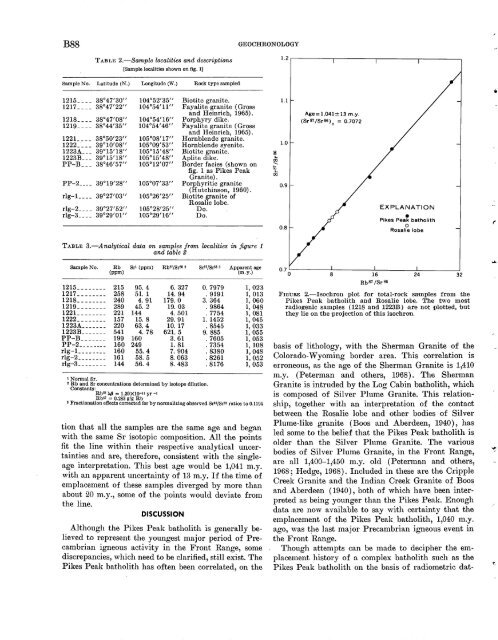RESEARCH· ·1970·
RESEARCH· ·1970·
RESEARCH· ·1970·
Create successful ePaper yourself
Turn your PDF publications into a flip-book with our unique Google optimized e-Paper software.
EXPLANATION<br />
Pikes Peak • batholith<br />
0<br />
Rosalie lobe<br />
TABLE 3.-Analytical data on samples from localities in figure 1<br />
and table 2<br />
Sample No.<br />
Rb<br />
(ppm)<br />
Sr1 (ppm) RbS7f8r86 2 SrB7/SrS6 3 Apparent age<br />
(m.y.)<br />
1215 ________ 215 95. 4 6. 327 0. 7979 1, 023<br />
1217 ________ 258 51. 1 14. 94 . 9191 1, 013<br />
1218 ________ 240 4. 91 179. 0 3. 364 1, 060<br />
1219 ________ 289 45. 2 19. 03 . 9864 1, 048<br />
122 L _______ 221 144 4. 501 . 7754 1, 081<br />
1222 ________ 157 15. 8 29. 91 1. 1452 1, 045<br />
1223A _______ 220 63.4 10. 17 . 8545 1, 033<br />
1223B _______ 541 4. 78 621. 5 9. 885 1, 055<br />
PP-B _______ 199 160 3. 61 . 7605 1, 053<br />
PP-2 ________ 160 249 1. 81 . 7354 1, 108<br />
rlg-L _______ 160 55.4 7. 904 . 8380 1,048<br />
rlg-2_ ------- 161 58. 5 8. 063 . 8261 1,052<br />
rlg-3 ________ 144 56.4 8. 483 . 8176 1, 053<br />
1 Normal Sr.<br />
2 Rb and Sr concentrations determined by isotope dilution.<br />
Constants:<br />
Rb87 >.{J = 1.39Xlo-u yr -1<br />
RbS7 = 0.283 g/g Rb<br />
a Fractionation effects corrected for by normalizing observed SrBGfSrss ratios to 0.1194<br />
tion that all the samples are the same age and began<br />
with the same Sr isotopic composition. All the points<br />
fit the line within their respective analytical uncertainties<br />
and are, therefore, consistent with the singleage<br />
interpretation. This best age would be ·1,041 m.y.<br />
with an apparent uncertainty of 13 m.y. If the time of<br />
emplacement of these samples diverged by more than<br />
about 20 m.y., some of the points would deviate from<br />
the line.<br />
DISCUSSION<br />
Although the Pikes Peak batholith is generally believed<br />
to represent the youngest major period of Precambrian<br />
igneous activity in the Front Range, some<br />
discrepancies, which need to be clarified, still exist. The<br />
Pikes Peak batholith has often been correlated, on the<br />
8<br />
16<br />
Rb87 /Sr 86<br />
24 32<br />
FIGURE 2.-Isochron plot for total-rock samples from the<br />
Pikes Peak batholith and Rosalie lobe. The two most<br />
radiogenic samples (1218 and 1223B) .are not plotted, ·but<br />
they lie on the projection of this isochrO'Il .<br />
basis of lithology, with the Sherman Granite of the<br />
Colorado-'Vyoming border area. This correlation is<br />
erroneous, as the age of the Sherman Granite is 1,410<br />
m.y. (Peterman and others, 1968). The Sherman<br />
Granite is intruded by the Log Cabin batholith, which<br />
is composed of Silver Plume Granite. This relationship,<br />
together with an interpretation of the contact<br />
between the Rosalie lobe and other bodies of Silver<br />
Plume-like granite (Boos and Aberdeen, 1940), has<br />
led some to the belief that the Pikes Peak batholith is<br />
older than the Silver Plume Granite. The various<br />
bodies of Silver Plume Granite, in the Front Range,<br />
are all 1,400-1,450 m.y. old (Peterman and others,<br />
1968; Hedge, 1968). Included in these are the Cripple<br />
Creek Granite and the Indian Creek Granite of Boos<br />
and Aberdeen ( 1940), both of which have been interpreted<br />
as being younger than the Pikes Peak. Enough<br />
data are now available to say with certainty that the<br />
emplacement of the Pikes Peak batholith, 1,040 m.y.<br />
ago, was t!1e last 1najor Precambrian igneous event in<br />
the Front Range.<br />
Though attempts can be made to decipher the mnplacement<br />
history of a complex batholith such as the<br />
Pikes Peak batholith on the basis of radiometric dat-
















